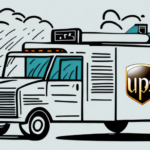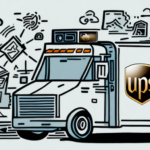Understanding UPS Delivery Options and Their Costs
UPS provides a comprehensive range of delivery services tailored to meet diverse shipping needs and budgets. From standard ground shipping to expedited international services, UPS ensures flexibility and reliability for both businesses and individuals.
UPS Ground
UPS Ground is the most economical option, ideal for packages that do not require expedited delivery. Typically, delivery times range from 1-5 business days within the continental United States. The cost is influenced by package weight, dimensions, and the distance between the origin and destination.
UPS 2nd Day Air
This service guarantees delivery within two business days, making it suitable for time-sensitive shipments. While more expensive than UPS Ground, UPS 2nd Day Air offers a balance between cost and speed, ensuring timely delivery for urgent packages.
UPS Next Day Air
For the fastest delivery available, UPS Next Day Air ensures packages arrive by the next business day. This premium service is ideal for critical shipments that require immediate attention, albeit at a higher cost.
UPS Worldwide Express
UPS Worldwide Express caters to international shipping needs, providing delivery within 1-3 business days to over 220 countries and territories. Pricing varies based on destination, package weight, and dimensions, making it essential to use the UPS shipping calculator for accurate estimates.
Calculating UPS Shipping Costs
Accurately calculating shipping costs with UPS involves considering multiple factors. Utilizing UPS's online shipping calculator can provide an estimate, but understanding the underlying components ensures better budgeting and cost management.
Key Factors in Cost Calculation
- Package Weight and Dimensions: Heavier and larger packages incur higher shipping fees.
- Distance: Longer shipping distances typically result in increased costs.
- Service Type: Faster delivery options like Next Day Air are more expensive than standard Ground services.
- Additional Services: Services such as package insurance, signature confirmation, and special handling add to the overall cost.
Using the UPS Shipping Calculator
The UPS Shipping Calculator is a valuable tool for estimating shipping costs. Entering accurate package details and selecting the desired service type will yield a reliable cost estimate, aiding in informed decision-making.
Factors Influencing UPS Shipping Costs
Several variables impact the cost of shipping with UPS. Understanding these factors can help shippers optimize their shipping strategies to minimize expenses.
Package Characteristics
The weight and dimensions of a package are primary determinants of shipping costs. UPS employs dimensional weight pricing, which considers the package's size relative to its actual weight, ensuring fair pricing for bulky items.
Service Selection
Choosing between different UPS services affects the overall cost. Expedited services come at a premium, while standard services offer cost savings for non-urgent shipments.
Shipping Distance
The distance between the origin and destination plays a significant role in pricing. Cross-country and international shipments typically cost more due to the increased transportation resources required.
Seasonal and Fuel Surcharges
During peak seasons or periods of high fuel costs, UPS may implement additional surcharges. Monitoring these fluctuations can help in budgeting and selecting the most cost-effective shipping periods.
Comparing UPS to Other Major Carriers
When evaluating UPS shipping costs, it's beneficial to compare them with other leading carriers like FedEx and the United States Postal Service (USPS) to determine the best value for your specific needs.
UPS vs. FedEx
Both UPS and FedEx offer similar services, including expedited and international shipping. Generally, UPS may offer more competitive ground shipping rates, while FedEx excels in overnight and international express services. Choosing between them depends on the priority of speed versus cost.
UPS vs. USPS
USPS is often the most economical choice for lightweight and domestic packages. However, UPS provides superior tracking capabilities and reliability for larger and international shipments. Businesses may prefer UPS for its extensive service options and global reach.
Cost and Reliability
While USPS tends to be cheaper for basic shipping needs, UPS offers higher reliability and faster delivery options. FedEx strikes a balance between speed and cost, making it a strong contender in the shipping market.
Strategies to Save on UPS Shipping Costs
Implementing cost-saving strategies can significantly reduce shipping expenses with UPS, benefiting both businesses and individual shippers.
Optimize Packaging
Using appropriately sized packaging minimizes dimensional weight charges. UPS offers a variety of packaging supplies that can help protect items while keeping costs low.
Consolidate Shipments
Shipping multiple packages together can lower overall costs due to bulk shipping discounts. Consolidation reduces the number of shipments, thus saving on cumulative shipping fees.
Leverage Discounts and Negotiated Rates
Businesses that ship frequently with UPS may qualify for discounted rates. Engaging with a UPS sales representative to negotiate rates based on shipping volume can lead to substantial savings.
Utilize UPS Online Tools
UPS offers various online tools, including the UPS Tools portal, which provides access to shipping calculators, tracking, and resource management. Efficient use of these tools can streamline shipping processes and reduce costs.
Potential Hidden Fees and How to Avoid Them
While UPS is transparent about most of its fees, certain hidden charges can inflate shipping costs unexpectedly. Being aware of these potential fees can help in avoiding unnecessary expenses.
Address Correction Fees
If a destination address is incorrect or incomplete, UPS may need to correct it, incurring additional fees. Ensuring accurate and complete address information before shipping can prevent these charges.
Oversize Package Fees
Packages that exceed UPS's size limitations are subject to oversize fees. Measuring and adhering to UPS's packaging guidelines can help avoid these extra costs.
Residential Delivery Fees
Shipping to residential addresses often incurs higher fees compared to commercial destinations. Planning shipments to align with commercial locations when possible can reduce residential delivery charges.
Fuel Surcharges
UPS implements fuel surcharges that fluctuate with fuel prices. While these are usually included in shipping quotes, being mindful of fuel surcharge periods can aid in budgeting.
Negotiating UPS Shipping Rates
For businesses with substantial shipping volumes, negotiating better rates with UPS can lead to significant cost reductions. Here are some effective strategies for negotiation:
Provide Accurate Shipping Data
Presenting detailed and accurate shipping data, including volume, frequency, and destinations, provides a solid foundation for negotiating favorable rates.
Compare Competitor Rates
Demonstrating knowledge of competing carriers' rates can strengthen your negotiating position, highlighting the need for UPS to offer competitive pricing.
Engage with a UPS Representative
Direct communication with a UPS sales representative allows for personalized discussions about shipping needs and potential discounts. Building a strong relationship with your representative can lead to ongoing cost benefits.
Leverage Long-Term Commitments
Committing to a long-term shipping relationship with UPS may open opportunities for better rates and exclusive offers, benefiting both parties in the long run.
Conclusion
Understanding the intricacies of UPS delivery services and their associated costs is essential for optimizing your shipping strategy. By leveraging the right services, employing cost-saving techniques, and being aware of potential hidden fees, both businesses and individuals can make informed decisions that align with their budget and delivery requirements. Additionally, negotiating favorable rates and staying informed about industry trends can further enhance the efficiency and cost-effectiveness of your shipping operations.






















